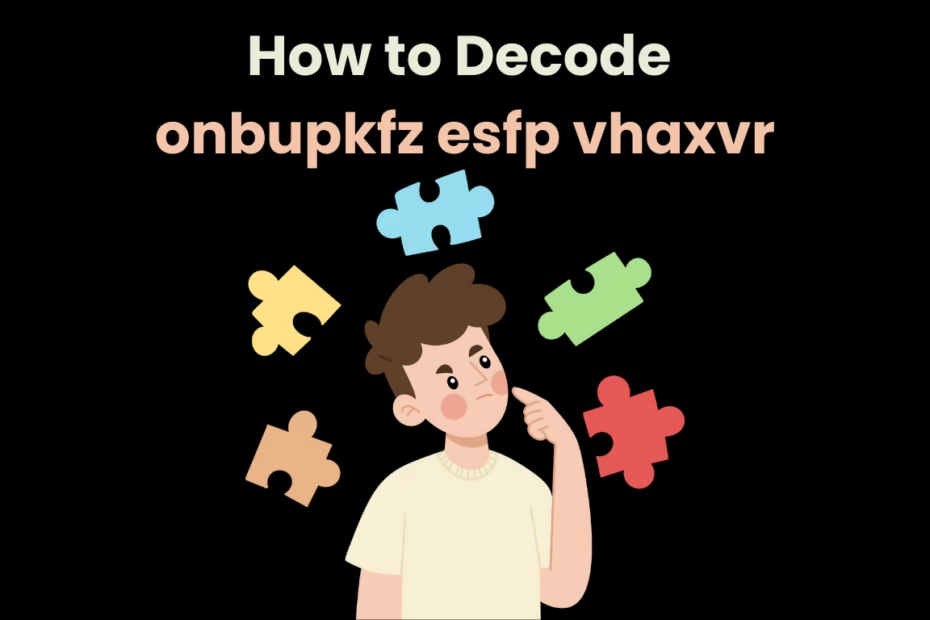🔍 Introduction
Have you ever stumbled across a bizarre phrase like “onbupkfz esfp vhaxvr” and thought, “What the heck does this mean?” You’re not alone. These kinds of weird-looking strings are often encoded messages, and cracking them open can be seriously satisfying—like solving a mystery with nothing but your brainpower.
In this article, we’re going full detective mode. You’ll learn what this phrase might represent, how to break it down, and how to decode messages like a pro.
🧠 Understanding the Nature of the Code
Is it a Cipher or a Code?
First, we need to get something straight: a cipher is not the same as a code.
-
A code replaces words or phrases with other symbols or words (like “Bravo” for “B” in the NATO alphabet).
-
A cipher, on the other hand, replaces individual letters or characters—and that’s likely what we’re dealing with here.
So “onbupkfz esfp vhaxvr” probably isn’t just a random phrase. It’s likely a ciphered message.
Possible Encryption Techniques
Caesar Cipher
One of the oldest tricks in the book—literally. This involves shifting each letter a fixed number of places in the alphabet. For example:
-
“A” becomes “D” with a shift of +3.
-
So “onbupkfz” might become something meaningful with a little push.
Substitution Cipher
This swaps letters for others, but not always in a uniform way. Think of the puzzle games you’ve played where:
-
A = Z
-
B = X
-
C = M
It’s like playing alphabet musical chairs.
Transposition Cipher
Instead of swapping letters, this method rearranges the order of them. Like turning “hello” into “lehlo.” Mind games, right?
Vigenère Cipher
This one uses a keyword to shift letters. It’s a bit trickier but more secure. The keyword acts like a padlock for the message.
🧩 Step-by-Step Approach to Decoding
Step 1 – Analyze Letter Frequency
Start by checking how often each letter appears. In English, E is super common, followed by T, A, O, I, N. Look for letters that show up often in “onbupkfz esfp vhaxvr.”
Step 2 – Look for Patterns
Let’s take a look:
-
“esfp” could resemble a four-letter word like “that,” “this,” or “word.”
-
“vhaxvr” might be “secret” or “decode.”
Step 3 – Try Simple Substitution
What if we guess “esfp” is “word”?
-
e = w
-
s = o
-
f = r
-
p = d
Apply that logic to the rest. You might find cracks forming in the wall of confusion.
Step 4 – Use Cipher Decoding Tools
If you hit a wall, there are online tools like:
Just paste the ciphered message in and try out different methods.
🔧 Tools You Can Use for Decoding
Online Decoders
-
Dcode – Best all-in-one tool for testing various ciphers.
-
Cryptii – Good for Vigenère and Caesar variations.
-
Boxentriq Cipher Identifier – Helps guess which cipher was used.
Manual Techniques
-
Pen and paper
-
Frequency analysis charts
-
Word pattern matching (especially with common English words)
Apps and Software
-
CryptoCrack
-
Cipher Solver
-
Kryptos for Android/iOS
These tools often come with ready-built frequency analysis and letter swapping functions.
🛡️ Real-Life Application of Codebreaking
Cybersecurity
Encryption is everywhere—from WhatsApp messages to secure banking transactions. Understanding how decoding works helps you appreciate online security better.
Cryptography in Messaging Apps
Apps like Signal and Telegram use advanced versions of the same principles you’re learning now. End-to-end encryption is just a beefed-up cipher.
Intelligence and Spy Agencies
Yes, James Bond vibes. Agencies like the NSA and GCHQ use advanced algorithms that have roots in these basic ciphers. Every pro started with simple decoding.
🚫 Common Mistakes to Avoid
Overcomplicating the Code
Sometimes we assume the message must be using military-grade encryption. Often, it’s just a basic Caesar cipher or letter swap.
Ignoring Context
Does the message appear in a game? A puzzle? On a website? Context gives clues.
Skipping Frequency Analysis
This step is often the fastest way to break a cipher. Don’t ignore it!
🎮 The Fun Side of Decoding
Puzzle Challenges and Escape Rooms
Many escape rooms include puzzles with coded messages. Crack one, and you might unlock a door—literally!
Cryptic Crosswords
These tricky puzzles rely heavily on wordplay and occasionally ciphers. Great brain workouts.
ARGs (Alternate Reality Games)
Games that blend real-life clues and stories, often with complex puzzles that use ciphers just like “onbupkfz esfp vhaxvr.”
Read More: The Ultimate Gaming Guide on MyGamerank
🧾 Final Thoughts
Decoding a phrase like “onbupkfz esfp vhaxvr” is like peeling an onion—layer by layer, you reveal the hidden message beneath. Whether you’re trying it for fun, solving a puzzle, or learning cryptography for a career, the skills you develop are as satisfying as they are useful.
So go ahead—put on your decoder hat and take the first step into a world of secrets waiting to be unlocked.
❓FAQs
1. What is the best first step to decode a message like “onbupkfz esfp vhaxvr”?
Start with a frequency analysis. It helps identify common letters that might map to “E”, “T”, “A”, etc.
2. Are there mobile apps for decoding ciphers?
Yes! Apps like CryptoCrack and Kryptos are great for on-the-go decoding.
3. Can AI help in decoding such messages?
Absolutely. AI-powered tools can analyze patterns and crack codes way faster than manual methods.
4. How do I know which cipher was used?
Use tools like Boxentriq Cipher Identifier to detect likely cipher types.
5. Is decoding legal?
Totally! As long as you’re not trying to hack into private or restricted data, playing with ciphers and puzzles is 100% legal and fun.

